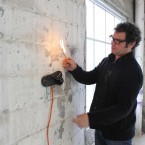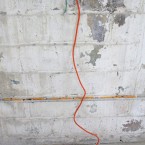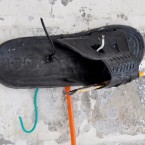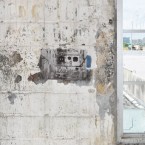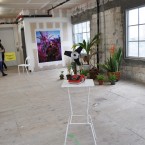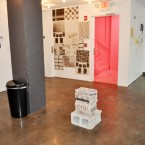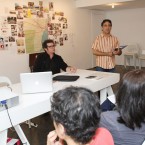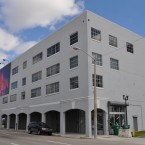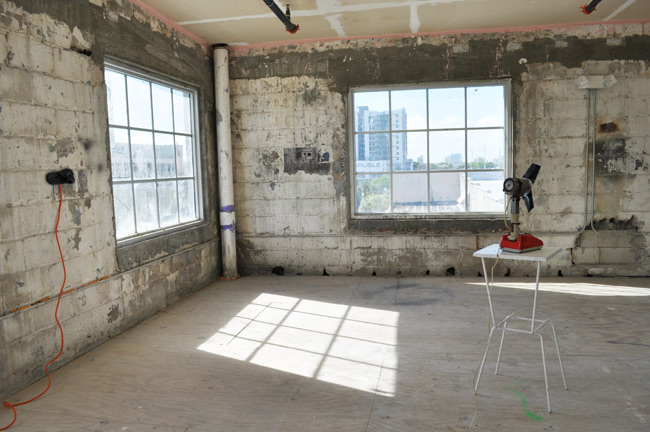
Light a fire with your house. Redrawing LegalArt’s building. Electrical system, pencil, plastic sandal, text on wall, action. 2011 (Left).
Moral Modulor’s Drawings Project “When anthropometric dimensions become a metaphor for moral dimensions”, newspaper, cut 2011 (center)
Potential House. From Architecture of Necessity, 2008 (right).
“Four Minutes, Thirty-Three Seconds” LegalArt, Miami. Curated by Omar Lopez-Chahoud. Press release
“Four Minutes, Thirty-Three Seconds” revisits the liberated attitude towards the creative process that defines the Fluxus movement. This project coincides with significant exhibitions happening at MOMA, NY; the Grey Art Gallery; NYU and at the Storefront for Art and Architecture, in collaboration with Performa 2011. This leads us to reflect on the similar attitudes between Fluxus actionists and a younger generation of artists as well as the socio-economic context in which these responses arise.
The title of this exhibition makes reference to a piece by composer John Cage, a notable influence on the Fluxus work of Lithuanian-born artist George Maciunas. Maciunas (1931-1978) organized the first Fluxus event in 1961 at the AG Gallery in New York City and the first Fluxus festivals in Europe. The Fluxus art movement in the 1960’s and 1970’s was characterized by a strongly Dadaist attitude, promoting artistic experimentation mixed with social and political activism. Often celebrated anarchistic change, Fluxus members avoided any limiting art theories and spurned pure aesthetic objectives. Their activities resulted in events or situations often called Aktions (works challenging the definition of art) and included performances, guerilla or street theater and concerts of electronic music, many of them similar to what in America were known as Happenings.
In the spirit of the Fluxus tradition, Omar Lopez-Chahoud has invited local and international artists, collaboratives, situationists, and curators to present projects in the form of publications, events, discussions, performances, situations, and other actions. These groups and individuals will activate the space in a way similar to the Happenings of the Fluxus Movement, inspired by an anti-art and anti-consumer enthusiasm. Participants in this exhibition include: Augurari Editions, Rodolfo Andaur, Hackworth Ashley, Spring Break, Monserrat Rojas Corradi, Cat Dove, Viking Funeral, Andrea Galvani, Jay Hines, Scott Hug, Karlo Ibarra, Carlos Irijalba, Brookhart Jonquil, Jason Keeling, Kristin Korolowicz, Liz Magic Laser, Nicolas Lobo, Gean Moreno, Richard Mosse, Ernesto Oroza, Gaston Persico, Manny Prieres, Print and Paste Collective (FAU), Megan Riley, Tom Scicluna, Joaquin Segura, SOMA, Natika Soward, Lara Stein Pardo, Suzanne Stroebe, Third Streaming/Yona Baker, Cecilia Szalkowicz, TM Sisters, Pinar Yolacan and others.
Omar Lopez-Chahoud has made use of his LegalArt residency as a lab for ideas, strategies and questions that organically shape the content of this exhibition. This project, like Cage’s composition, creates a potential space for creative energy and responses, facilitating a fertile dialog with the community outside of the traditional gallery venue. Publications produced by artists, curators, and art organizations will be available for research on the second floor of LegalArt. The exhibition continues on the fourth floor with multimedia installations and performances.
read Art in America review
- Light a fire with your house. Redrawing LegalArt’s building. Electrical system, pencil, plastic sandal, text on wall, action. 2011. © Kerry McLaney
- Light a fire with your house. Redrawing LegalArt’s building. Electrical system, pencil, text on wall, plastic sandal, action. 2011. © Kerry McLaney
- (detail) Light a fire with your house. Redrawing LegalArt’s building. Electrical system, pencil, plastic sandal, text on wall, action. 2011
- Moral Modulor’s Drawings Project “When anthropometric dimensions become a metaphor for moral dimensions”, newspaper, cut, 2011
- Potential House. From Architecture of Necessity, 2008 (right).
- Tabloids, 2008-2011 www.thetabloid.org
- Ernesto Oroza lecture on Architecture of Necessity.
- Redibujando el hogar. Diagram from Architecture of necessity
Rethinking home from a pragmatic and criminal perspective. I am using the electrical system to “redrawing” the house. The action is connected with thousands of gestures individules that reimagine the urban infrastructures.
